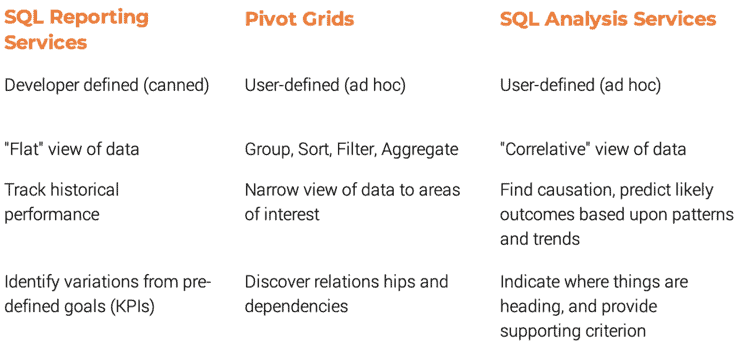
SQL Server Index Tuning Audit
PCApps provides SQL Server Analysis Services consulting, and custom .NET application design and development.

Extracting Intelligence From Your Data
Investments in separate line-of-business systems can often lead to “siloed” databases that are difficult to correlate and analyze. Traditional approaches to building business decision-support systems include: swapping one relational reporting system for another, extracting and transforming (ETL) the data into a centralized data warehouse, or purchasing a separate BI application on the promise of more flexible, robust reporting. These approaches can be expensive, and the results can be unpredictable. Excel pivot tables can be just as effective, but complex Excel-based systems are difficult to maintain, and do not scale well for most data gathering and analysis needs. Talk about the more “innovative” approaches instead of the flaws with the traditional approach
SQL Server Analysis Services (SSAS)
Microsoft® SQL Server Analysis Services (SSAS) provides a unified, fully-integrated view of your business data to support online analytical processing (OLAP), key performance indicators (KPI), and powerful data mining capabilities. SQL Server Analysis Services greatly reduces the amount of effort required to integrate data from multiple systems into a unified, consistent format, and report against the data using a variety of formats and techniques e.g mining the data for relationships, or forecasting future results with predictive analytics. PCApps provides SQL Server Analysis Services consulting, and custom .NET application design and development services to help you create a reliable and cost-effective approach to analyzing your business data.
SQL Reporting Services Vs. Pivit Grids Vs. SQL Server Analysis Services

Simple, Integrated View Of Data
The data for common business functions — enterprise resource planning (ERP), CRM, SCM, Inventory, Human Resources, Accounting, and so on — is often maintained in separate applications, from separate vendors, and each uses different terminology, data schemas, and database engines. Business decision-makers often require an “integrated view” of their data to make informed decisions. Microsoft SQL Server 2008 and SQL Server 2012 Analysis Services address this challenge through the use of data source views that allow the creation of analytical models against existing data structures. Unified Dimensional Models and Perspectives create a single data view that can be exposed as virtual data marts to individual departments.
Intelligent View Of Data
Most warehousing tools today build rigid hierarchical structures to allow analysts to drill up and down into the data. However, powerful, drilling up and down is not the only form of analysis that can be performed. Microsoft SQL Server 2008 and SQL Server 2012 Analysis Services allows businesses to build solutions that support flexible hierarchies, many-to-many relationships, and other dimension types that allow for more advanced analytics.
Localized Analytics Experience
Businesses with operations that span languages must consolidate data into a single language and currency in order for analysis to be valid, but this makes it more difficult for organizations worldwide to use the solution. Thanks to a feature called Translations, Microsoft SQL Server 2008, SQL Server 2012 and SQL Server 2014 Analysis Services lets companies build a single solution that can localize values on the fly depending on the user’s location.
Real-Time BI
Most business intelligence (BI) and data warehousing solutions are snapshots in time that are updated nightly or weekly. Real-time BI solutions exist but tend to be very slow compared to snapshots. Microsoft SQL Server 2005 Analysis Services gives businesses the ability to have real time or near real time BI capabilities with snapshot-like speeds and minimal impact on production systems.










